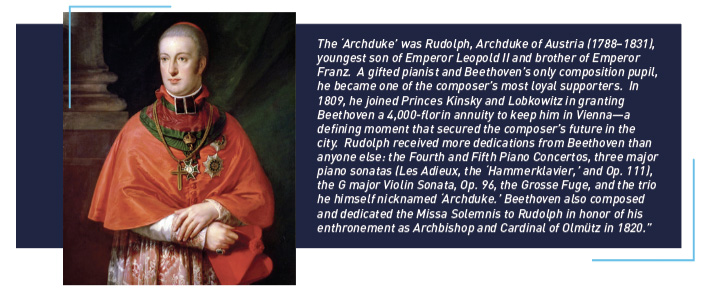Composed 1810-11; 41 minutes
The ‘Archduke’ Trio represents the peak of Beethoven’s writing for piano trio: virtuosic music, written for virtuoso players. In the previous two decades he had been known to view the medium of the piano trio—three instruments that were among the most widely taught—as a commercially viable outlet. That explains works like the ‘Kakadu’ Variations and the trio arrangements of the Septet and even the Second Symphony—either made by Beethoven himself or issued with his approval. The amateur market was large, and he understood it well. Yet his very first published works, the Op. 1 trios, would have given pause for thought amongst amateurs accustomed to reading through music at sight. With the two Op. 70 trios—especially the better-known ‘Ghost’—Beethoven sets the bar even higher, unambiguously writing for professionals. In the ‘Archduke’, he delivers a monumental four-movement work lasting 40 minutes, transforming the piano trio from salon-scale intimacy into something approaching a concerto in scope.
From the start, Beethoven reimagines the sonority of the medium. The piano textures are denser, the chords more resonant. The cello sings more of the melody, and the ensemble sound is warmer and fuller. The music recalls the lyrical breadth of the Fourth Piano Concerto and looks ahead to ideas explored in Beethoven’s late works. Though the opening movement spans a vast canvas and speaks in elevated tones, its initial gesture is
not declamatory but marked dolce—sweetly. This is music of depth, shaped by maturity and hard-won
emotional insight.
As in the ‘Hammerklavier’ Sonata, Beethoven reverses the order of the middle movements. The Scherzo brims with dry wit, echoing the idiom of the First ‘Razumovsky’ Quartet. Its playful repetitions, shimmering textures, and shadowy turns are laced with one of the most enchanting Viennese waltzes Beethoven ever wrote. The ethereal slow movement is among Beethoven's most majestic statements. It contains a noble theme with five variations, and, as in the late string quartets, it forms the emotional heart of the piece. Then comes the finale, breaking the spell with rustic energy. Its grounded, driving character reflects Beethoven’s improvisational habits: just when his listeners were swept up, he’d smash a fist on the keys and erupt in laughter. Broad, buoyant, and full of life, the finale brings this expansive masterpiece to a rousing close.
— All program notes copyright © 2025 Keith Horner.
Comments welcomed: khnotes@sympatico.ca
